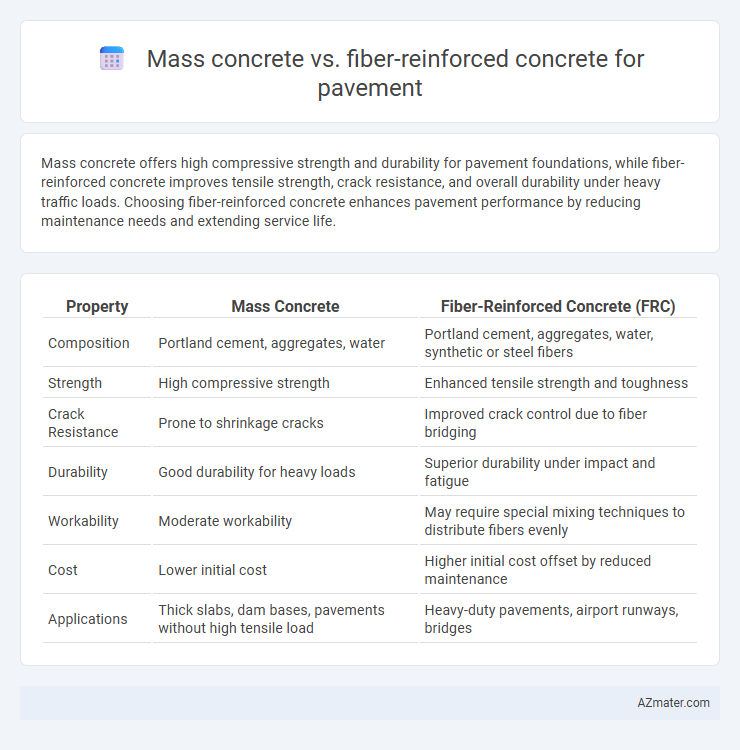Mass concrete offers high compressive strength and durability for pavement foundations, while fiber-reinforced concrete improves tensile strength, crack resistance, and overall durability under heavy traffic loads. Choosing fiber-reinforced concrete enhances pavement performance by reducing maintenance needs and extending service life.
Table of Comparison
| Property | Mass Concrete | Fiber-Reinforced Concrete (FRC) |
|---|---|---|
| Composition | Portland cement, aggregates, water | Portland cement, aggregates, water, synthetic or steel fibers |
| Strength | High compressive strength | Enhanced tensile strength and toughness |
| Crack Resistance | Prone to shrinkage cracks | Improved crack control due to fiber bridging |
| Durability | Good durability for heavy loads | Superior durability under impact and fatigue |
| Workability | Moderate workability | May require special mixing techniques to distribute fibers evenly |
| Cost | Lower initial cost | Higher initial cost offset by reduced maintenance |
| Applications | Thick slabs, dam bases, pavements without high tensile load | Heavy-duty pavements, airport runways, bridges |
Introduction to Pavement Concrete Types
Pavement concrete is primarily categorized into mass concrete and fiber-reinforced concrete, each offering distinct structural benefits for road construction. Mass concrete is a dense, solid material designed for high compressive strength and durability, often used in heavy-load applications such as highways and industrial pavements. Fiber-reinforced concrete incorporates synthetic or steel fibers to enhance tensile strength, crack resistance, and impact durability, making it suitable for pavements subjected to dynamic loads and reducing maintenance costs over time.
Defining Mass Concrete
Mass concrete is defined by its large volume, typically exceeding 1 cubic meter, which necessitates careful thermal control to prevent cracking due to heat generated during cement hydration. It is characterized by low tensile strength and minimal reinforcement, relying on its mass to resist structural loads, commonly used in thick pavement slabs and foundation bases. Fiber-reinforced concrete incorporates synthetic or steel fibers to improve tensile strength, crack resistance, and durability, offering enhanced performance over traditional mass concrete in pavement applications.
What is Fiber-Reinforced Concrete?
Fiber-reinforced concrete (FRC) incorporates discrete fibers such as steel, glass, synthetic, or natural fibers into the concrete mix to enhance tensile strength, toughness, and crack resistance. Unlike mass concrete, which relies on its volume and mass for stability, FRC improves pavement durability by reducing shrinkage and improving impact resistance. FRC is particularly advantageous in pavements subjected to heavy traffic, freeze-thaw cycles, and dynamic loads, extending service life and lowering maintenance costs.
Key Material Properties Comparison
Mass concrete for pavement exhibits high compressive strength and durability, but limited tensile strength and crack resistance, often requiring expansion joints to control deformation. Fiber-reinforced concrete enhances tensile strength, toughness, and crack control through the integration of steel, glass, or synthetic fibers, improving overall pavement durability and reducing maintenance costs. The modulus of elasticity and shrinkage properties in fiber-reinforced mixes contribute to better load distribution and resistance to thermal and shrinkage stresses compared to traditional mass concrete.
Strength and Durability Factors
Mass concrete for pavement offers high compressive strength but is prone to shrinkage cracks and thermal stresses, which can reduce long-term durability. Fiber-reinforced concrete enhances tensile strength and crack resistance through the incorporation of synthetic or steel fibers, leading to improved load distribution and increased durability under dynamic traffic conditions. The use of fibers also mitigates shrinkage cracking and improves impact resistance, resulting in a more resilient pavement structure compared to conventional mass concrete.
Crack Resistance and Shrinkage Performance
Mass concrete used in pavement generally exhibits higher risk of cracking due to thermal stresses and shrinkage, which result from internal temperature gradients during curing. Fiber-reinforced concrete enhances crack resistance by distributing stresses through synthetic or steel fibers, reducing microcrack formation and controlling shrinkage more effectively. Studies indicate fiber addition can reduce crack width by up to 60% and shrinkage strain by approximately 30%, improving durability and lifespan of pavement structures.
Thermal Stress Management
Mass concrete in pavement construction often encounters significant thermal stress due to its large volume causing uneven temperature gradients, leading to cracking and structural damage. Fiber-reinforced concrete enhances thermal stress management by distributing thermal strains more evenly and controlling crack propagation through the inclusion of synthetic or steel fibers. This results in improved durability and reduced maintenance costs in pavement applications subjected to temperature fluctuations.
Installation and Construction Practices
Mass concrete for pavement involves straightforward placement techniques using large volumes of concrete with minimal reinforcement, emphasizing bulk and compressive strength for stability. Fiber-reinforced concrete requires specialized mixing procedures to ensure uniform fiber distribution, enhancing tensile strength and crack resistance, which reduces joint spacing and finishing efforts. Installation of fiber-reinforced concrete often accelerates construction due to fewer control joints and improved durability, while mass concrete demands careful temperature control and curing to prevent thermal cracking.
Cost Implications and Lifecycle Analysis
Mass concrete used in pavement construction typically involves lower initial material costs but higher labor expenses due to longer curing times and the need for extensive formwork. Fiber-reinforced concrete, incorporating synthetic or steel fibers, increases upfront costs by 10-20% but reduces maintenance and repair expenses through improved crack resistance and durability. Lifecycle analysis indicates fiber-reinforced concrete extends pavement service life by 15-30%, leading to lower total cost of ownership and enhanced return on investment over 20-30 years.
Best Applications: Choosing the Right Concrete for Pavement
Mass concrete excels in large-scale pavement projects requiring high compressive strength and durability under heavy loads, ideal for industrial yards and airport runways. Fiber-reinforced concrete enhances crack resistance and flexural strength, making it best suited for highways, bridge decks, and pavements exposed to dynamic traffic stresses. Selecting the appropriate concrete depends on factors such as load intensity, environmental conditions, and maintenance needs to ensure long-term performance.

Infographic: Mass concrete vs Fiber-reinforced concrete for Pavement
 azmater.com
azmater.com